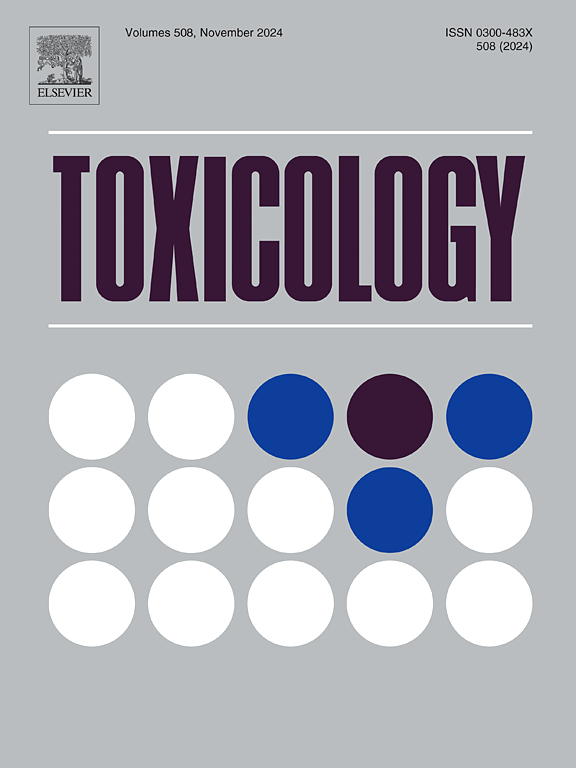Oral exposure to tire rubber-derived contaminant 6PPD and 6PPD-quinone induces intestinal toxicity in mice
IF 4.6
3区 医学
Q1 PHARMACOLOGY & PHARMACY
引用次数: 0
Abstract
N-(1,3-dimethylbutyl)-N′-phenyl-p-phenylenediamine (6PPD) is a commonly used rubber protectant that continuously enters the environment via groundwater. Its oxidation product, N-(1,3-dimethylbutyl)-N′-phenyl-p-phenylenediamine quinone (6PPDQ), has garnered significant concern due to its reported toxicity in animals. This study aims to evaluate the intestinal toxicity and potential metabolic impact of 6PPD and 6PPDQ in mice following oral exposure to various doses. Our results demonstrate that both compounds compromise the intestinal barrier, as evidenced by significant increases in the expression of tight junction proteins (claudin-1 and occludin) and mucin protein (MUC2). These changes suggest an impairment of both the physical and chemical barriers of the intestine. Following exposure, there was a marked increase in pro-inflammatory cytokines (IL-6, IL-22, and NOD-1), indicating an inflammatory response associated with the disruption of lipid metabolism and macrophage polarization. Specifically, the shift from M2 to M1 macrophage polarization correlates with increased expression of M1 markers despite no change in the M1/M2 ratio over prolonged exposure. Furthermore, 6PPD exposure significantly reduced gut microbiota richness and evenness, with more pronounced changes observed in the 6PPDQ-treated group. Correlation analysis suggested that these microbial shifts may influence host carnitine and lipid metabolism pathways. Ultimately, both 6PPD and 6PPDQ exposure led to elevated levels of total cholesterol (TC), triglycerides (TG), and low-density lipoprotein (LDL) in the bloodstream, attributed to decreased TC esterification. These findings highlight the potential long-term health risks associated with environmental exposure to 6PPD and 6PPDQ, particularly concerning gut integrity and metabolic dysregulation.
Synopsis
This study investigates the toxicity of 6PPD and its transformation product 6PPDQ, revealing their detrimental effects on intestinal health, disruption of gut microbiota, and alterations in lipid metabolism, highlighting significant implications for both environmental and human health.
口服轮胎橡胶衍生污染物6PPD和6PPD醌可诱导小鼠肠道毒性
N-(1,3-二甲基丁基)-N′-苯基-对苯二胺(6PPD)是一种常用的橡胶保护剂,通过地下水不断进入环境。其氧化产物N-(1,3-二甲基丁基)-N ' -苯基-对苯二胺醌(6PPDQ)由于其对动物的毒性报道而引起了极大的关注。本研究旨在评估口服不同剂量6PPD和6PPDQ对小鼠的肠道毒性和潜在代谢影响。我们的研究结果表明,这两种化合物都会破坏肠道屏障,紧密连接蛋白(claudin-1和occludin)和粘蛋白(MUC2)的表达显著增加。这些变化表明肠道的物理和化学屏障都受到了损害。暴露后,促炎细胞因子(IL-6、IL-22和NOD-1)显著增加,表明炎症反应与脂质代谢破坏和巨噬细胞极化有关。具体来说,巨噬细胞从M2向M1极化的转变与M1标记物的表达增加相关,尽管长期暴露后M1/M2比值没有变化。此外,6PPD暴露显著降低了肠道微生物群的丰富度和均匀性,在6ppdq处理组观察到更明显的变化。相关分析表明,这些微生物变化可能影响宿主肉碱和脂质代谢途径。最终,6PPD和6PPDQ暴露导致血液中总胆固醇(TC)、甘油三酯(TG)和低密度脂蛋白(LDL)水平升高,原因是TC酯化降低。这些发现强调了与6PPD和6PPDQ环境暴露相关的潜在长期健康风险,特别是在肠道完整性和代谢失调方面。本研究研究了6PPD及其转化产物6PPDQ的毒性,揭示了它们对肠道健康、肠道微生物群破坏和脂质代谢的有害影响,强调了对环境和人类健康的重要影响。
本文章由计算机程序翻译,如有差异,请以英文原文为准。
求助全文
约1分钟内获得全文
求助全文
来源期刊

Toxicology
医学-毒理学
CiteScore
7.80
自引率
4.40%
发文量
222
审稿时长
23 days
期刊介绍:
Toxicology is an international, peer-reviewed journal that publishes only the highest quality original scientific research and critical reviews describing hypothesis-based investigations into mechanisms of toxicity associated with exposures to xenobiotic chemicals, particularly as it relates to human health. In this respect "mechanisms" is defined on both the macro (e.g. physiological, biological, kinetic, species, sex, etc.) and molecular (genomic, transcriptomic, metabolic, etc.) scale. Emphasis is placed on findings that identify novel hazards and that can be extrapolated to exposures and mechanisms that are relevant to estimating human risk. Toxicology also publishes brief communications, personal commentaries and opinion articles, as well as concise expert reviews on contemporary topics. All research and review articles published in Toxicology are subject to rigorous peer review. Authors are asked to contact the Editor-in-Chief prior to submitting review articles or commentaries for consideration for publication in Toxicology.
 求助内容:
求助内容: 应助结果提醒方式:
应助结果提醒方式:


